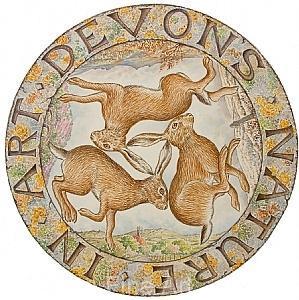What do the ‘three hares’ mean?
What do the ‘three hares’ mean?

A warning against sin? Or a way to advertise good fortune? A fascinating book ranges from Devon to China in its search for the origin of an enigmatic image
Three hares race round in an endless circle. Each has two ears, yet there are only three ears in total as each ear is shared by two hares. It’s a powerful image, puzzling yet satisfying.
Tom Greeves, a former archaeologist with the Dartmoor National Park Authority, first saw it in 1967 on the cover of a book about Dartmoor folklore. Twenty years later, he saw another – this time on an oak roof boss of a 15th-century church in the Dartmoor village of Throwleigh.
“A black-robed monk, when shown the three hares, declares robustly ‘Not Christian! Animals!’”
When he returned in 1989 with photographer Chris Chapman, a local artist told them the symbol could also be found in Buddhist caves in China. Intrigue turned to passion. Along the way, art historian Sue Andrew joined up for a global quest to find more.
In The Three Hares, the trio tell their fascinating story, starting in England and Wales. But the pace hot ups in France and Germany, with a cast of baroque characters. There’s the black-robed Benedictine monk, who, when shown the three hares, declares robustly: “Not Christian! Animals!” And then there’s the chainsaw carver with a stone, three-hares boss built into his home, who poses with his bare-chested son – both wielding axes.
The authors travel to China to see the sacred Buddhist Magao caves, near the old Silk Road town of Dunhuang. The symbol was painted at the centre of elaborate ceiling representations of textile canopies dating from the Sui and Tang dynasties (AD 581 to 907). A retired local researcher explained that much of the painting was done while trade thrived along the Silk Road, so the symbol may have come from ancient Persia.
Another key artefact is a 13th-century copper coin with the hares motif on one side, and on the other, names of two Mongol leaders and Islamic references. For the authors, this may be fresh evidence of the importance of religious and cultural tolerance in the Mongols’ empire-building success.
But as ever with interpretation, nothing is certain. When Greeves began his research in the west country, the Three Hares were known in Devon as “The Tinners’ Rabbits”. Local writers described them as the mark of tin miners giving thanks for rich finds by rebuilding or enlarging churches.
Greeves was sceptical. His research revealed no link, with the motif all but absent from the tin-producing areas of Cornwall, and the ears’ length more in keeping with hares than rabbits.
So what does it mean? The three hares symbol on a 13th-century bell in the former Cistercian monastery of Kloster Haina, Germany, was believed to avert evil influences. Elsewhere in medieval Germany, in France and in Devon, it was seen as a warning to resist temptation and confess to sins. The symbol also appears in a 1309 Jewish manuscript, as well as in several Ukrainian synagogues in later centuries.
Greeves concludes that while the meaning has varied across religions and cultures, the ubiquity of the hares symbol attests to its importance. Modern observers are free to create their own interpretations, he says. He also hopes sharing knowledge of beautiful things that connected civilisations across religion and time may help unite disparate peoples in a fractured age.
The authors are clear their book is not the final say on the mysterious symbol. But readers left frustrated by this should remember that animals in an eternal circle never stop.
Be the first to post a message!